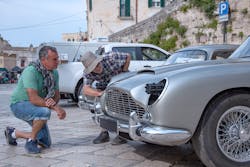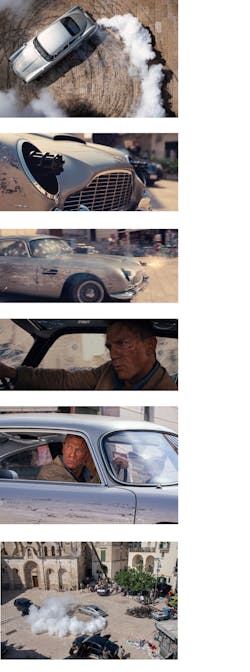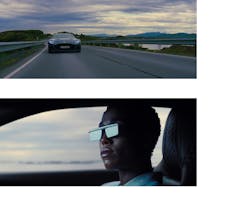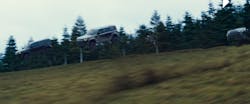No Time to Die... Driving
I admit it. I’ve been a Bond fanatic ever since I saw Doctor No when it was first released. The gadgets were amazing as were the cars. Aston Martins have played a central role in a host of Bond films, with fast car chases doing seemingly impossible stunts. The latest incarnation is No Time To Die, and I had a chance to talk with the film’s Special Effects Supervisor, Chris Corbould (Fig. 1). He has worked on numerous movies, including many Bond films.
These days, computer-generated imagery (CGI) is the norm. especially with sci-fi and action films. However, sometimes old-fashioned stunt driving and special effects are what’s needed, and this new film has a mix, including half-a-dozen cars and vehicles where stunt driving and real effects dominate. A quick synopsis of the film:
“In No Time To Die, Bond has left active service and is enjoying a tranquil life in Jamaica. His peace is short-lived when his old friend Felix Leiter from the CIA turns up asking for help. The mission to rescue a kidnapped scientist turns out to be far more treacherous than expected, leading Bond onto the trail of a mysterious villain armed with dangerous new technology.”
The scene filmed in Matera, Italy has a tricked-out Aston Martin DB5 driven in full battle mode, literally, by Daniel Craig as James Bond (Fig. 2). The DB5 is equipped with dual M134 mini-guns, bulletproof glass, and smokescreen generators. Eight carbon-body, stunt versions were made for the movie, with Mark Higgins doing some of the stunt driving. If you have a few million, there’s a run of about 25 new Aston Martin Continuation DB5s being built.
The car first appeared in Goldfinger and one was destroyed in the movie Skyfall. It also has appeared in Thunderball, GoldenEye, Tomorrow Never Dies, Casino Royale, and Spectre. Sean Connery and Pierce Brosnan were at the wheel in addition to Daniel Craig.
Nomi, the new 007, gets to ride in an Aston Martin DBS Superleggera (Fig. 3). You need to watch the movie to see this car in action as well as the Aston Martin V8 Vantage that Bonds rolls through London, England.
The Land Rover Series III scenes (Fig. 4) filmed in Jamaica highlight some of the changes that have been made possible with the latest automotive technology ranging from self-driving cars to remote-control drones. On the plus side, hooking into a car’s control system is much easier today versus the fully mechanical cars of yore.
These days, it’s possible to mount a pod on the roof of a car with a driver that’s really controlling the vehicle. Cameras in the car with the actors can film the action without having to use technologies like green screens to put scenes in the background. Shooting the entire scene live, while the car is moving, causes momentum and centrifugal force to affect the actors.
The pods also can be remote-controlled when necessary, and various techniques that provide feedback to the real driver have been used, such as virtual-reality goggles. It’s not bad for exercises like racing drones, but it can be a bit different when trying to muscle around a Land Rover. As it turns out, having a driver in a second car, with its own driver, following or running next to the car being controlled, often works better because the remote driver can feel the road effects.
Revamping cars was nothing new for Chris. For example, the ice lake chase scene in Die Another Day really needed four-wheel drive for safety and effects. However, the Jaguar and Aston Martin cars did not come with that option. A trek back to the shop turned these two-wheel-drive cars into four-wheel-drive monsters that also were equipped with auto-inflating air bags sufficient to keep the cars afloat should the ice they were driving over prove insufficient support for these new, weighty autos.
Another idea Chris had was used in GoldenEye, where the chase scene was originally intended to be a motorcycle chase. Instead, Bond gets to drive a tank, which provided some new options such as going through obstacles rather than around.
While the results on screen are amazing, the actual creation is challenging and can be dangerous, so don’t try these stunts at home—especially when six high-speed vehicles must be choreographed. Adding CGI to the mix can enhance a scene, crop out things the director doesn’t want in the scene, as well as add virtual items to the video. Quite a few of the scenes in No Time to Die are more CGI than live. However, when it comes to the cars, what you see is what you get.
About the Author
William G. Wong
Senior Content Director - Electronic Design and Microwaves & RF
I am Editor of Electronic Design focusing on embedded, software, and systems. As Senior Content Director, I also manage Microwaves & RF and I work with a great team of editors to provide engineers, programmers, developers and technical managers with interesting and useful articles and videos on a regular basis. Check out our free newsletters to see the latest content.
You can send press releases for new products for possible coverage on the website. I am also interested in receiving contributed articles for publishing on our website. Use our template and send to me along with a signed release form.
Check out my blog, AltEmbedded on Electronic Design, as well as his latest articles on this site that are listed below.
You can visit my social media via these links:
- AltEmbedded on Electronic Design
- Bill Wong on Facebook
- @AltEmbedded on Twitter
- Bill Wong on LinkedIn
I earned a Bachelor of Electrical Engineering at the Georgia Institute of Technology and a Masters in Computer Science from Rutgers University. I still do a bit of programming using everything from C and C++ to Rust and Ada/SPARK. I do a bit of PHP programming for Drupal websites. I have posted a few Drupal modules.
I still get a hand on software and electronic hardware. Some of this can be found on our Kit Close-Up video series. You can also see me on many of our TechXchange Talk videos. I am interested in a range of projects from robotics to artificial intelligence.




